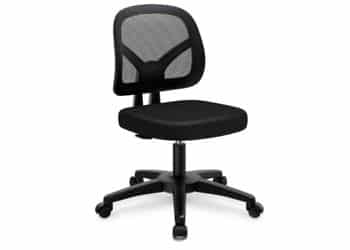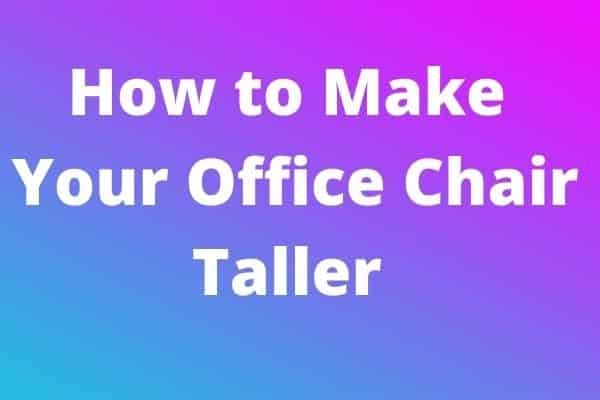Office chairs come in a variety of shapes and styles. However, these chairs are primarily constructed with comfort and ease in mind. These chairs must be highly comfy and pleasant for individuals to sit all day and work well.
Every aspect of life has benefited from technology, and the chair business is no different. With furniture advancing at a breakneck pace, chairs have significantly improved functionality to provide much-needed comfort. Numerous variables contribute to its suitability, but one of the most important is its height adaptability.
If your chair lacks a lever, you may be wondering how to modify its height. Thus, in this blog, we discussed several of the most common methods for adjusting the size of your chair without using a lever.
Determine The Correct Height
Before adjusting the chair’s height, the first step is determining the optimal height. The optimal height varies by individual. Additionally, it varies according to office surroundings, table height, and other factors. As a result, you must determine your optimal height.
- Adjust the size of your table. You may need to adjust it slightly higher if the keyboard and other items are located towards the table’s edge. Additionally, the height of your desk affects your optimal height.
- When seated in a chair, your feet should be parallel to the floor. The thighs should be horizontal, and the legs should be at a 90-degree angle.
- Once you’ve determined the optimal height, mark it and stand. The mark will assist you in making an appropriate adjustment for your circumstances.
Turn Chair Clockwise or Anti-Clockwise

It is perhaps the most straightforward method for adjusting a chair’s height without using a lever. Certain chairs do not have a lever for height adjustment. But they may feature a clockwise and anti-clockwise movement mechanism. With these types of seats, the procedure of adjusting the height is quite simple:
- Begin rotating your chair counter-clockwise. If the height increases, continue spinning counter-clockwise until the chair reaches the required height.
- If the chair’s height decreases as you turn clockwise, reverse the direction you’re rotating until the chair reaches the required height.
- Continue tilting the chair in opposite directions until you reach the desired height.
Bolt Adjustment
You typically adjust office chairs without levers through a big bolt at the base. The following actions can help you achieve your optimal height:
- Ascend the chair and physically adjust the bolt beneath it.
- By adjusting the bolt, you can adjust the height of the chair. Note the direction in which the height increases and stops immediately after the chair reaches the required size.
- Ascertain that the chair’s height is comfortable by sitting in it.
- Repeat the procedure if the chair height requires additional adjustment. After achieving the desired size, secure the bolt to maintain the seat’s height.
Related article: How to Make Office Chair Taller
Back Height Adjustment
Numerous chairs allow you to customize the back and armrests of the chair. Adjusting the arms is also critical for achieving the optimal chair seating position. As a result, you can determine whether your chair provides restricted or complete back and arm adjustment possibilities.
Some chairs’ backrests allow forward and backward movement, while others allow for up and down motion. In some models, you can even alter the recline of your chair. Thus, the core concept is comparable here as well.
- Adjusting the height of the arms and back adds to the comfort.
- Continue twisting the parts until you find the optimal position based on your options.
- Assess your comfort level by sitting in and managing your chair.
Using Wooden Pieces
You can utilize wooden parts to add a few inches to the height. This procedure will take a little more time and effort because it entails removing and rebinding screws.
- You need to insert the wooden parts between the seat and the chair’s lower section. You’ll need to use a drill to drill a hole through the wooden piece.
- For a secure grasp, you must utilize a 22-inch wooden piece. After that, you must pass the long screws and nuts through those holes. The chair’s screw count determines the quantity of wood used.
- You can insert the wooden pieces between the seat and the lower section. After adjusting them, reattach the seatback. It will enable you to elevate the chair a few inches.
Threaded Post
Another excellent technique for adjusting the office chair is to utilize a threaded post. Numerous chairs feature a threaded post that allows for height adjustment.
- To begin, invert the chair and coat the threaded post with lubricant.
- Clear the excess oil with a rag to prevent the chair from slipping while you work on it. It will also assist you in cleaning any dirt or debris that may have accumulated over several years of use. Indeed, dirt can make lowering and raising the chair height more difficult.
- Grasp the base with one of your feet. It will stifle the chair’s right- or left-side movement. The next step is to adjust the chair’s height as necessary by turning it clockwise or anti-clockwise. Turn it counter-clockwise to increase the height.
- Spin the chair to continue adjusting the height. If you find a significant difference in the height of your chair, now is the time to take a measurement. Stop spinning the chair once it has reached the desired height. As you sit in the chair, consider the height difference.
- If you believe the chair requires additional height, spin it a few more times. Each spin elevates the chair by about 1/4 inch. Thus, to raise a chair approximately 2 inches, you must counter-clockwise spin it approximately eight times.
Conclusion
Appropriately adjusting the height of an office chair will relieve the strain off your back. Sitting in an uncomfortable chair can cause you to slump, crouch forward, and type at an unnatural angle. If left unchecked, any of these disorders might result in pain or disability.
Fortunately, these issues can frequently be prevented by simply altering the height of your office chair. You can avoid sitting awkwardly by adjusting the chair’s controls.

I’m Justin Allen, found of mychairreviews.com where I review gaming chairs, massage chairs, recliners for people who are looking to buy one. I love writing things on the internet and blogging about anything that interests me which is usually video games, technology, or sports-related items. When I am not working on blog posts or reviewing products I have a passion for you can find me playing video games with friends online!



